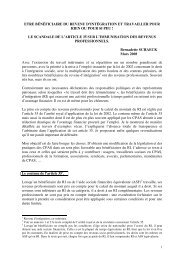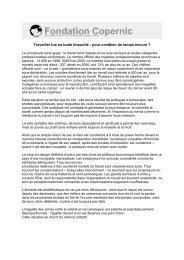Awra Amba RJ 300612 EN - Contacter un comité local d'Attac
Awra Amba RJ 300612 EN - Contacter un comité local d'Attac
Awra Amba RJ 300612 EN - Contacter un comité local d'Attac
Create successful ePaper yourself
Turn your PDF publications into a flip-book with our unique Google optimized e-Paper software.
<strong>Awra</strong> <strong>Amba</strong>, a current experiment of utopian socialism<br />
These committees meet at least once a year and vote by a show of hands (Jo10b/9).<br />
Committee Men Women Total<br />
Development 4 1 5<br />
Controlling development committee 1 2 3<br />
Weekly development 4 1 5<br />
Controlling weekly development committee 1 2 3<br />
Education 3 2 5<br />
Patients care 2 3 5<br />
Elderly care 3 2 5<br />
Sanitation 2 1 3<br />
Problem solving 1 2 3<br />
Work assignment 1 2 3<br />
Complaint hearing 1 2 3<br />
Security 3 0 3<br />
Lost money handling 2 1 3<br />
Reception 2 2 4<br />
By law preparation 8 7 15<br />
Total 38 30 68<br />
Table 3:<br />
Participation to the fifteen 2005 committees (Atnafu, 2005/62). Colours indicate the<br />
egalitarian (in blue), or very low participation (in red) of women.<br />
4.2. Economic activities<br />
According to Ya08/2 and 126, the Ethiopian are familiar with collective and cooperative work, in<br />
agriculture (Debo, Wenfel), trade, army, as well as for many social events (Idir, Equb). In addition, in<br />
the recent past, the cooperatives were encouraged by the government for improving the economy of<br />
the comm<strong>un</strong>ities. However, the <strong>Awra</strong> <strong>Amba</strong> cooperative has not been created at the initiative of an<br />
external authority, but at the initiative of the cooperative members themselves.<br />
The economy of <strong>Awra</strong> <strong>Amba</strong> is partially an agricultural economy, following the alternately dry and<br />
wet seasons: the agricultural work is more important during the wet season, the cooperative taking<br />
over during the dry season mainly through weaving.<br />
The cultivated area is 10.23 ha according to Ya08/97 (much more – 28.2 – according to At05/28),<br />
and is not irrigated (At05/38). It gives a cultivated area per household of 0.11 or 0.29 ha, which is<br />
much lower than the average figure of the woreda of 1.4 ha. When the areas of grassland are<br />
included, we get a surface farmed per <strong>Awra</strong> <strong>Amba</strong> household of about 0.16 ha or 0.41 ha, whereas<br />
the figure for the woreda is 2.1 ha: <strong>Awra</strong> <strong>Amba</strong> is far to be able to live from its land. Its cereal<br />
production per inhabitant was anyway in 2006 39 kg/inh/year, when the standard is 225 kg/inh/year<br />
in wheat (Ya08/103).<br />
Surface (ha) Production (q) Yield (q/ha) <br />
Tef 5.75 32 5.6 <br />
Maize 3.73 118 31.6 <br />
Beans (bollokie) 0.75 5 6.7 <br />
Total 10.23 155 15.1 <br />
Table 4: Farming production and yield of the cooperative in 2006, acc. to Yassin (2008/98).<br />
The main productions are sorghum (or maize: the author mentions sorghum in the text and maize in<br />
44 / 85

















